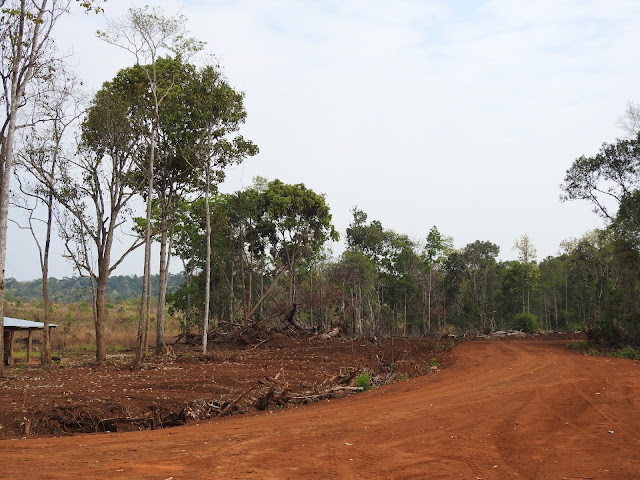Three weeks plus in Cambodia is an adventure! We encountered
a great range of nearly 300 species of birds; [too] many that were threatened –
some critically so. We saw amazing ancient history and experienced stories of
their brutal not-so-distant-past. We enjoyed amazing food and saw ways of lives
that have disappeared from much of the world. We were lucky to have been able
to travel and stay in relative comfort, given Cambodia’s state of development.
Lucky, too, we were in our guide Sophal Chen aka Naran the
main man. Naran was a very, very good
guide with excellent knowledge of birds and one saw again and again his quiet
compassion and true joy in seeing and photographing Cambodian nature [even
species that he had no doubt photographed many times before]. That was special.
‘A smiling Buddha’ was how he described himself and like that man he remained
calm and unruffled despite heat and stress and ants invading picnic lunches and
constant questions and our petty concerns and requests. The only time he became
a little stressed was enduring the pain of the bullshit of Bokor National Park
and the vandalism described as development within.
Credit, too, to our drivers
who nearly lasted the whole trip with an unblemished record despite the chaos
of Cambodian traffic – their last day ending with a minor smash!
Everyone saw lifers and many got many. Even our guide, Naran
scored three. The birds can be summarised by our group’s top ten – derived mathematically.
1.
Bar Bellied Pitta
2.
Slaty legged Crake
3.
Cambodian Tailorbird & Oriental Bay Owl
4.
Long tailed Broadbill
5.
Red headed Vulture
6.
Giant Ibis & Bengal Florican & Mekong
Wagtail
7.
Milky Stork & Collared Falconet & Large
tailed Nightjar
Now these species were obviously selected according to the
perspectives of each of the participants as were the birds of the day on pages
past. Some species were selected because of uniqueness or endemism [or regional
endemism] or the quality of the view and / or their threatened status.
We were also lucky to get an insight into the conservation ‘scene’
in Cambodia. Sadly there is not a great argument for optimism. While Cambodian
Bird Guides Association and the similar Sam Veasna are promoting local grass roots
campaigns and projects and these are having local effects more active and well
funded NGO’s and projects are needed. Most importantly, and I claim this
without having any idea on how to achieve it, a Cambodian Government [with some
integrity and free of corruption] is needed to make and enforce thoughtful laws
regarding the preservation and conservation of their natural resources,
biodiversity and endangered species. Failures in the government respecting
protected areas that they do have points to continued and serious problems in
fauna protection.
Hunting, a tradition sadly in no real danger of dying out,
continues putting more wildlife at risk. Case in Point Eld’s Deer, a species
listed in our information as easy to find proved impossible to find with Naran
claiming that they had not been seen this year! Perhaps they have, through
hunting, become locally extinct for the area that they are usually found in is
within a Nature Reserve [set up most specifically for the endangered Sarus Cranes].
At several places we heard gunshots; if not hunters then I am yet to think of
another possible theory.
Deforestation is continuing, clearly. Many places, deemed
reserves, seemed to be reserved for illegal logging. In many areas key trees
have been logged, cut up in-situ and then the remaining vegetation burned and agriculture
emerging among the still smoking ruins.
Population, a perennial global issue, remains an issue in
Cambodia. And, of course, it contributes, as does capitalism, to the loss of
biodiversity.
If responsible governance was available Rewilding could be
part of the solution for Cambodia’s wildlife. Reserves, established in the
relatively lowly populated northern plains, could potentially, be rewilded. The
original fauna, in some instances absent for decades or even centuries, could
be returned and thereby further encouraging a tourist trade in wildlife viewing
[but having the result of biodiversity protection]. Case in point; in the
northern plains there exists populations of three critically endangered vulture
species. These birds are critically endangered globally for a variety of
reasons but, chief among them, was the spectacular decline because of a drug
used on cattle in India named Difxxxx. Currently the birds need to be fed as
many of the big mammals in this area have been hunted out. To save the vultures
their ‘prey’ species need to be returned. Potentially wild cattle [Asian Water
Buffalo, Gaur, Banteng], Sambar and perhaps Eld’s Deer could be reintroduced or
have their populations supplemented. Wild Boars remain but are probably quite
low in numbers. Most exciting though; perhaps tigers and leopards could /
should be brought back offering a unique ‘safari experience’ that would be
truly indo-chinese. Btw Elephants and rhinos were there too…. Imaginary I know
but there is no harm in thinking out loud….Rewilding [creating something new]
is perhaps easier to get supporters for than trying to save existing last
fragments…























































